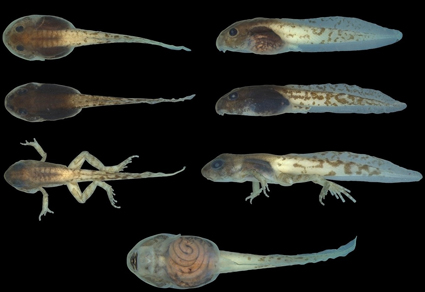References
- Altig, R. & McDiarmid, R.W. (1999) Body plan: development and morphology. In: McDiarmid, R.W. & Altig, R. (Eds.), Tadpoles: The Biology of Anuran Larvae. The University of Chicago Press, Chicago, Illinois, pp. 24−51.
- Costa, R.C., Facure, K.G. & Giaretta. A.A. (2006) Courtship, vocalization, and tadpole description of Epipedobates flavopictus (Anura: Dendrobatidae) in southern Goiás, Brazil. Biota Neotropica, 6, 1–9. https://doi.org/10.1590/S1676-06032006000100006
- Dias, P.H.S, Brandão, A.P. & Grant, T. (2018) The buccopharyngeal morphology of the tadpole of Ameerega flavopicta (Anura: Dendrobatidae: Colostethinae), with a redescription of its external morphology. Herpetologica, 74, 323–328. https://doi.org/10.1655/0018-0831.323
- Duellman, W.E. (1978) The biology of an equatorial herpetofauna in Amazonian Ecuador. University of Kansas Natural History Museum, Miscellaneous Publication, 65, 1–352.
- Duellman, W.E. (2005) Cusco Amazonico: The lives of amphibians and reptiles in an Amazonian rainforest. Comstock Publishing Associates, Cornell University, New York, New York, 433 pp.
- Frost, D.R. (2024) Amphibian species of the world: an online reference, version 6.0 (20 January 2024). American Museum of Natural History, USA. Available from: http://research.amnh.org/vz/herpetology/amphibia/Amphibia/Anura/Dendrobatoidea/Dendrobatidae/Colostethinae/Ameerega/Ameerega-berohoka (accessed 5 June 2024)
- Gosner, K.L. (1960) A simplified table for staging anuran embryos and larvae with notes on identification. Herpetologica, 16, 183–190.
- Grant, T., Rada, M.A., Anganoy-Criollo, M., Batista, A., Dias, P.H., Jeckel, A.M., Machado, D.J. & Rueda, J.V. (2017) Phylogenetic systematics of dart-poison frogs and their relatives revisited (Anura: Dendrobatoidea). South American Journal of Herpetology, 12, 1–90. https://doi.org/10.2994/SAJH-D-17-00017.1
- Guillory, W.X., French, C.M., Twomey, E.M., Chávez, G., Prates, I., Von May, R., De la Riva, I., Lötters, S., Reichle, S., Serrano-Rojas, S.J., Whitworth, A. & Brown, J.L. (2020) Phylogenetic relationships and systematics of the Amazonian poison frog genus Ameerega using ultraconserved genomic elements. Molecular Phylogenetics and Evolution, 142, 106638. https://doi.org/10.1016/j.ympev.2019.106638
- Haddad, C.F.B. & Martins, M. (1994) Four species of poison frogs related to Epipedobates pictus (Dendrobatidae): Taxonomy and natural history observations. Herpetologica, 50, 282–295.
- Lavilla, E.O. & Scrocchi, G.J. (1986) Morfometría larval de los géneros de Telmatobiinae (Anura: Leptodactylidae) de Argentina y Chile. Physis, 44, 39–43.
- Lescure, J. (1976) Etude de tetards de Phyllobates (Dendrobatidae): P. femoralis (Boulenger) et P. pictus (Bibron). Extrait du Bulletin de la Societe Zoologique de France, 101, 299–306.
- Lötters, S., Debold, P., Henle, K., Glaw, F. & Kneller, M. (1997) Ein neuer Pfeilgiftfrosch aus der Epipedobates pictus-Gruppe vom Osthang der Cordillera Azul in Peru. Herpetofauna, 19, 25–34.
- Menin, M., Pinto, R.M.C., Pegorini, R.J. & Silva, M.R. (2017) Redescription of the tadpole of Ameerega hahneli (Boulenger, 1884) (Anura: Dendrobatidae) with notes on ontogenetic variations and development habits. South American Journal of Herpetology, 12, 236–243. https://doi.org/10.2994/SAJH-D-17-00052.1
- Myers, C.W. & Daly, J.W. (1979) A name for the poison frog of Cordillera Azul, Eastern Peru, with notes on its biology and skin toxins (Dendrobatidae). American Museum Novitates, 2674, 1–24.
- Pezzuti T.L., Araujo, R.B., Sanches, P.R., Pedroso-Santos, F., Dias-Souza, M.R. & Costa-Campos, C.E. (2022) The tadpole of the endemic poison frog Ameerega pulchripecta (Silverstone, 1976) with the description of its chondrocranium (Anura: Dendrobatidae: Colostethinae). Zootaxa, 5115 (2), 295–300. https://doi.org/10.11646/zootaxa.5115.2.9
- Poelman, E.H., Verkade, J.C., Wijngaarden, R.P.A. van. & Félix-Novoa, C. (2010) Descriptions of the tadpoles of two poison frogs, Ameerega parvula and Ameerega bilinguis (Anura: Dendrobatidae) from Ecuador. Journal of Herpetology, 44, 409–417. https://doi.org/10.1670/09-017.1
- Rodríguez, L.O. & Duellman, W.E. (1994) Guide to the frogs of the Iquitos region, Amazon Peru. Special Publication. The University of Kansas, Natural History Museum, Special Publication No. 22. Asociación de Ecología y Conservación, and Amazon Center for Environmental Education and Research and Natural History Museum, the University of Kansas, Lawrence, Kansas, 80 pp. https://doi.org/10.5962/bhl.title.7937
- Rodríguez, L. & Myers, C.W. (1993) A new poison frog from Manu National Park, southeastern Peru (Dendrobatidae, Epipedobates). American Museum Novitates, 3068, 1–15.
- Sánchez, D.M. (2013) Larval morphology of dart-poison frogs (Anura: Dendrobatoidea: Aromobatidae and Dendrobatidae). Zootaxa, 3637 (5), 569–591. https://doi.org/10.11646/zootaxa.3637.5.5
- Santos, D.L., Feio, R.N. & Nomura, F. (2023) Morphological characterization and taxonomic key for tadpoles of Brazilian Cerrado. Biota Neotropica, 23, 1–43. https://doi.org/10.1590/1676-0611-bn-2023-1486
- Schulze, A., Jansen, M. & Kohler, J. (2015) Tadpole diversity of Bolivia’s lowland anuran communities: Molecular identification, morphological characterization, and ecological assignment. Zootaxa, 4016 (1), 1–111. https://doi.org/10.11646/zootaxa.4016.1.1
- Silverstone, P.A. (1976) A revision of the poison-arrow frogs of the genus Phyllobates Bibron in Sagra (Family Dendrobatidae). Natural History Museum of Los Angeles County Science Bulletin, 27, 1–53.
- Twomey, E. & Brown, J.L. (2008) A partial revision of the Ameerega hahneli complex (Anura: Dendrobatidae) and a new cryptic species from the east-Andean versant of Central Peru. Zootaxa, 1757 (1), 49–65. https://doi.org/10.11646/zootaxa.1757.1.3
- Wyman, J. (1859) On some unusual modes of gestation. American Journal of Science, 27, 1–5.


